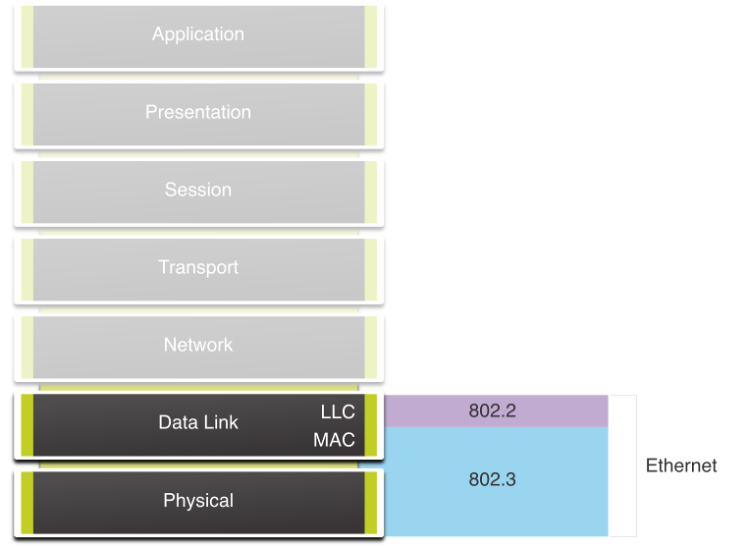
About Lesson
Ethernet Frames
Explain how the Ethernet sublayers are related to the frame fields.
Ethernet Encapsulation
- Ethernet operates in the data link layer and the physical layer. It is a family of networking technologies defined in the IEEE 802.2 and 802.3 standards.

Data Link Sublayers
The 802 LAN/MAN standards, including Ethernet, use two separate sublayers of the data link layer to operate:
- LLC Sublayer: (IEEE 802.2) Places information in the frame to identify which network layer protocol is used for the frame.
- MAC Sublayer: (IEEE 802.3, 802.11, or 802.15) Responsible for data encapsulation and media access control, and provides data link layer addressing.

MAC Sublayer
The MAC sublayer is responsible for data encapsulation and accessing the media. 
Data Encapsulation
IEEE 802.3 data encapsulation includes the following:
- Ethernet frame – This is the internal structure of the Ethernet frame.
- Ethernet Addressing – The Ethernet frame includes both a source and destination MAC address to deliver the Ethernet frame from Ethernet NIC to Ethernet NIC on the same LAN.
- Ethernet Error detection – The Ethernet frame includes a frame check sequence (FCS) trailer used for error detection.
Media Access
- The IEEE 802.3 MAC sublayer includes the specifications for different Ethernet communications standards over various types of media including copper and fiber.
- Legacy Ethernet using a bus topology or hubs, is a shared, half-duplex medium. Ethernet over a half-duplex medium uses a contention-based access method, carrier sense multiple access/collision detection (CSMA/CD).
- Ethernet LANs of today use switches that operate in full-duplex. Full-duplex communications with Ethernet switches do not require access control through CSMA/CD.
Ethernet Frame Fields
- The minimum Ethernet frame size is 64 bytes and the maximum is 1518 bytes. The preamble field is not included when describing the size of the frame.
- Any frame less than 64 bytes in length is considered a “collision fragment” or “runt frame” and is automatically discarded. Frames with more than 1500 bytes of data are considered “jumbo” or “baby giant frames”.
- If the size of a transmitted frame is less than the minimum, or greater than the maximum, the receiving device drops the frame. Dropped frames are likely to be the result of collisions or other unwanted signals. They are considered invalid. Jumbo frames are usually supported by most Fast Ethernet and Gigabit Ethernet switches and NICs.

Other related topics
| Topic Title | Topic Objective |
|---|---|
| Ethernet Frame | Explain how the Ethernet sublayers are related to the frame fields. |
| Ethernet MAC Address | Describe the Ethernet MAC address. |
| The MAC Address Table | Explain how a switch builds its MAC address table and forwards frames. |
| Switch Speeds and Forwarding Methods | Describe switch forwarding methods and port settings available on Layer 2 switch ports. |
Other useful information
- Full CCNA Course
- CCNA Certificate Information
- 200-301 CCNA Exam Questions and Solutions
- 200-301 CCNA Exam Topics
Join the conversation